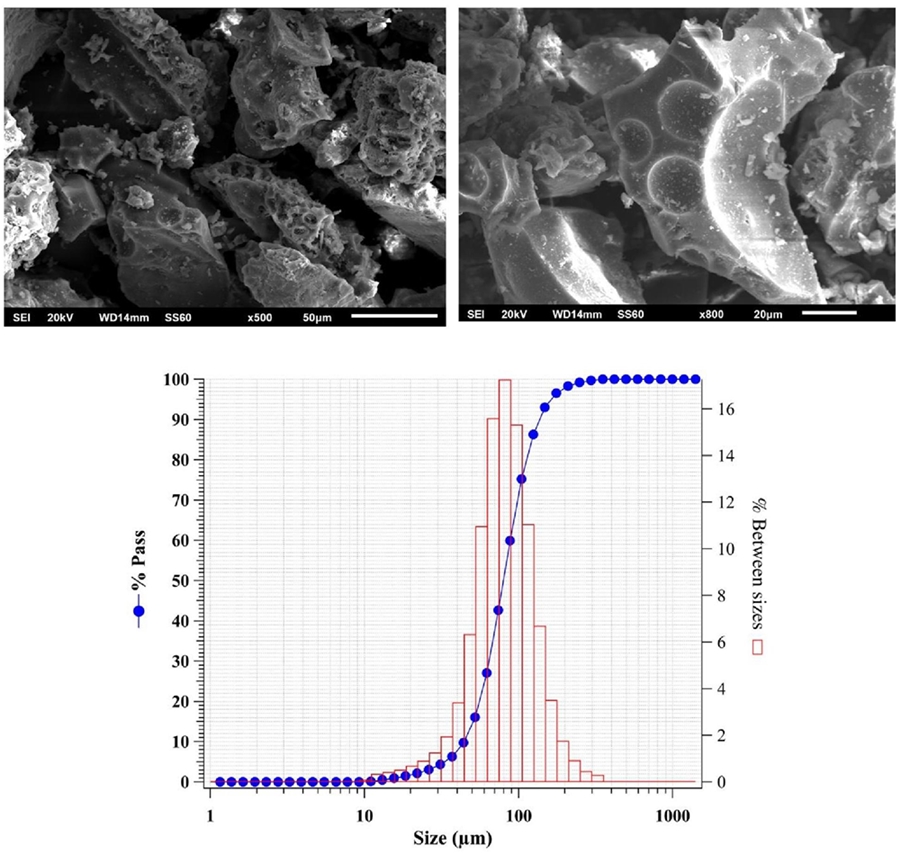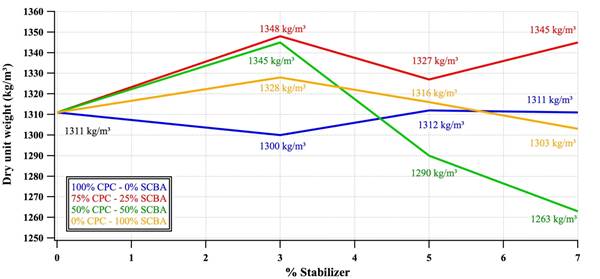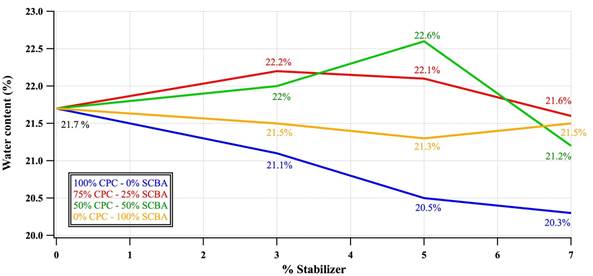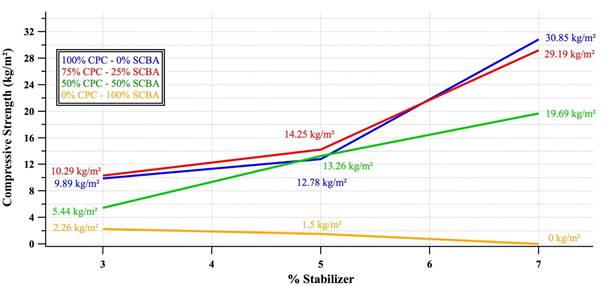1. INTRODUCTION
On roads infrastructure works, the soils located on the projection zone are the main materials used for embankments construction, therefore, its performance is important to a suitable service life on any functional structure. These soils when being used in engineering must fulfill established quality requirements on international codes, and if they do not fulfill these requirements then they must be improved, mainly on volumetric stability and strength characteristics. (Fernández Loaiza, 1982; Jofre et al.,2008; Juárez & Inzunza, 2011).
The improvement of soils are related with compaction process and addition of stabilizer agents and both have a direct influence on the quality control of conformed layers, strength soil structures, economy and contributions to sustainability (Rico-Rodriguez & Del Castillo, 2006).
Further, the addition of agents that act by physicochemical principles has been one of the most techniques employed in treatment of soils, materials like lime, portland cement, asphalt, fly ash, blast-furnace slag, rice husk ash among other, have been subject to research and analysis due their influence on soils of different classifications (Behak & Perez Nuñez, 2008; Cristelo, Glendinning, Miranda, & Oliveira, 2012; Sargent, Hughes, Rouainia, & Glendinning, 2012; S. Correia & Graca Rasteiro, 2016) because have been observed increases on the durability and strength due to the pysicochemical process occured on blend; furthermore, poozolanic materials it has been used for reducing the comsumption of portland cement, lime and asphalt due to the high energetic required, and genetarion of CO2 during its proccess.
Nowadays SCBA is one of the most researched supplementary material as a replacement of portland cement in concrete and mortar mixes (Moraes et al., 2015), SCBA is a recent alternative in soil improvement both in physical characteristics as confinement, density and volumetric stability, as well as chemical characteristics due to chemical reactions of the stabilization agent (lime or cement) with water and in exceptional cases with the constitutive of soil (mainly clay), where its use as construction material contributes to solving problems of generation and disposal of agro industrial wastes, that only in Mexico their 57 sugar factory in harvest period 2016-2017 ground 53,308,643 tons of cane of the 777,078 hectares harvest, obtaining 15,222,471 tons of bagasse (CONADESUCA, 2017) that once burned becomes ash whose final disposition is not determinate. Several studies have reported that the combustion of bagasse ash in boilers produce a sub product called sugar cane bagasse ash (SCBA), having higher contents of silica and alumina as main oxides, that in appropriate conditions have a reaction with calcium hydroxide producing a pozzolanic activity (Cordeiro & Kurtis, 2017). This activity is function of particle size, amorphous material contents (silicoaluminates), calcium hydroxide present and optimum water content, saying some researchers, the ash that is not consuming during the reaction can be used as a filler material, filling the voids present in compound material (Sing, Singh, & Rai, 2000; Cordeiro, Toledo Filho, Tavares, & Fairbairn, 2008; Cordeiro, Toledo, & Fairbairn, 2009; Morales, Villar Cociña, Frias, Santos, & Savastano, 2009; Arenas Piedrahita et al., 2016; Joshaghani & Amin, 2017; ) and where on a dynamicly compacted soil it would offer an alternative to increas its stability due to filler effect of voids on compacting soil and a possible pozzolanic reaction to late ages.
The aim of the present work is determinate the influence of partials substitution of CPC for SCBA on compacting properties, compressive strength and CBR of a sand granular soil, in order to improve its mechanical characteristics and to be used in pavement structural layer, taking advantage materials of agro industrial waste and reduce the percentages of cement employed in soil stabilization, that despite being small percentages of addition, generated an environmental and economic impact due to growing construction of roads over the world.
1. EXPERIMENTAL PROCEDURE
1.1 Materials
The materials used in this study were portland cement, classified type III or CPC 30R as is established in standards (ASTM C150, 2017; NMX C414, 2004, respectively) which density = 3.11 g/cm3. Sugar cane bagasse ash obtained from sugar factory “Mahuixtlan” in Coatepec, Veracruz Mexico. The SCBA was obtained from one boiler where the combustion temperature was around to 700 ºC. The ash collected was cooled and grinding to 1500 rpm for 1 hour, getting the material passing the sieve No 200. The density of SCBA was 2.1 g/cm3.
The grinding process was used to decrease the particle size under 75 microns in order to increase the specific surface area, which is related to the increase of pozzolanic reactivity of SCBA as several authors have described (Cordeiro G. C., Toledo Filho, Tavares, & Rego Fairbairn, 2009; Cordeiro & Kurtis, 2017).
The soil used in this study was obtained from material bank el Castillo in Xalapa, Veracruz Mexico. The sampling, identification, conditioning of samples and test it was carried out as is established in the procedures to analyses and assessment of embankments conformation (ASTM D 2217, 1998; ASTM D 421, 2007; ASTM D 2216, 2010; ASTM D 698, 2012; ASTM D 4318, 2017).
1.2 Materials characterization.
Chemical composition of SCBA was obtained by x ray fluorescence analysis (XRF), the ash phases was determinate by x ray diffraction (XRD), morphology and surface characteristics were observed by scanning electron microscopy (SEM), particle size distribution (PSD) was obtained as well by laser diffraction granulometric analyze, in order to know the average size of ash particles.
1.3 Soil mixing design
In the mixing design three percentages of portland cement were used according to the material classification, in this case for granular materials as sand used in this study the addition percentages must be less of 10% in order to do not have cracking due to high stiffening, as are established in several technical prescriptions (Jofre et al., 2008; Juarez Gutierrez & Inzunza Ortiz, 2011). The percentages used were 3%, 5% y 7% with respect to dry soil weigh. The partial substitution on each percentage mentioned 0%, 25%, 50% y 100%, having 12 mixes in total.
1.4 Compacting characteristics.
Compaction is a mechanical process that improves the strength characteristics of materials which constitute structural sections in roads, for it, the impact energy is transferred by unitary volume of soil, obtaining a compaction curve which shows the dry unit weight and water content parameters of material. For this work, the ratio between dry unit weight and water content were determinate on each mix, in order to analyze the variation due to the additions and as data for making the specimens soil-cement. The tests were carried out following the procedure to granular materials using molds 944 cm3, and dynamic compacting with rammer 2.5 kg weight and 30.48 cm height of drop (ASTM D558, 2011).
1.5 CBR test
CBR is penetration strength test that compares support capacity of material in the study to crushed stone well graduate as a reference (100% CBR). For it, the load is applied through one piston with strain of 1.3 mm per minute recovering loads from 0.64 mm to 7.62 mm; In this work the CBR test was determinate on each mix in study, for it, three specimens for mix was dynamically compacted to optimum water content followed by to place surcharge weights and place it in immersion period for 24 h simulating the critical conditions followed of test on the loading machine to deformation velocity described (ASTM D1883, 2016).
1.6 Unconfined compressive strength
For assessment compressive strength of mixes, soil-cement and soil-cement-SCBA specimens were made to 100% compacting degree. These specimens were prepared as established the procedure for soil stabilized with cement (ASTM D558, 2011), using the values of compacting characteristics obtained previously. Dimension of specimens was 101.6 mm diameter and 116.4 mm high, with a high-diameter ratio of 1.15.
Samples were extracted of the mold by mechanical extractor and curing in water during 7 days. The specimens tests were made following the procedure compressive strength on soil-cement specimens (ASTM D1633, 2017), for it, previously to test, they were submerged in water for a period of 4 h in order to obtain the critical conditions followed by the test in an automatically loading machine.
2. RESULTS AND DISCUSSION
2.1 Physicochemical characterization of materials.
Table 1 shows the characterization results of soil in study. This table shows the geotechnical parameters, it can observe that the predominate material is sand with 89.5% passing sieve No 4 and 20.7% passing sieve No 200, according to plasticity results there is not interval between liquid limit and plastic limit, concluding that fine material present in sample is not plastics, that means that it has a material with granular characteristics with specific gravity 2.0, according to unified soil classification system it is SM silty sand (ASTM D 2487, 2011). The compacting characteristics show that the optimal water content to produce a dry unit weigh of 1311 kg/m3 was 21.7%, and CBR value was 24% with 0 % expansion, satisfy the characteristics to use in subgrade layer as the Mexican rules established (Rico Rodríguez, Orozco y Orozco, Telles Gutierrez, & Perez García, 1990)
Table 1 Geotechnical characteristics of granular soil in study.
| Properties | Results |
|---|---|
| Natural Humidity (%) | 22.38 |
| Pass sieve 3” (%) | 100 |
| Pass sieve No 4 (%) | 89.50 |
| Pass sieve No 200 (%) | 20.70 |
| Liquid limit (%) | 31.2 |
| Plastic limit (%) | N/P |
| Plastic index (%) | N/P |
| Maximum dry density (kg/m3) | 1311 |
| Optimal humidity (%) | 21.7 |
| Density | 2.0 |
| CBR (%) | 24.5 |
| Expansion (%) | 0 |
Table 2 shows chemical composition of SCBA, it can be observed that sum of main oxides (SiO2+Al2O3+Fe2O3) were 73.069%, being up to 70% the minimum, as established the pozzolanic standard, furthermore it has loss of ignition 1.5% having classification of class N (ASTM C 618, 2017).
These results has been contrasted with different researchers that have used SCBA as supplementary material to portland cement, having consistency with them (Frias, Villar, & Savastano, 2011; Ganesan, Rajagopal, & Thangavel, 2007).
Table 2 Chemical composition of sugar cane bagasse ash in study.
| Compound | Concentration |
|---|---|
| SiO2 | 62.66 |
| Al2O3 | 5.20 |
| Fe2O3 | 5.19 |
| TiO2 | 0.64 |
| CaO | 4.87 |
| MgO | 2.19 |
| SO3 | 0.30 |
| K2O | 13.93 |
| Na2O | 0.56 |
| P2O5 | 3.36 |
| Density (g/cm3) | 2.1 |
| Loss ignition (%) | 1.5 |
Figure 1 shows phases present in SCBA by diffraction patron, it can be observed amorphous particles presents in halo localized between 10 - 40º, 2( region, it is observed that on SCBA the main compounds are tridymite, kyanite, potassium oxide, iron oxide and silicon-aluminum oxide as crystalline materials. Similar diffractograms has been obtained of several authors, coinciding to mark off the region describing before (Jagadesh, Ramachandramurthy, Murugesan, & Sarayu, 2015; Torres Rivas, Gaitan Arevalo, Espinoza Perez, & Escalante Garcia, 2014).
Figure 2 shows the SEM analysis on SCBA particles, it can be observed irregular and elongated shapes particles of tridymite (SiO2) mix, and porous particles of ash also is observed to 500x, the several sizes can be observed taking as reference 50 (m scale on micrograph. On the other hand, at 800x is observed tridymite particles with grains of less size between 20 (m y 40 (m. The morphology found is associate to process and temperature of burned of bagasse as it has been reported by several researchers. Additionally, the same figure shows particle size distribution of SCBA particles, observing a uniform size distribution, namely, the SCBA is compound to particles from 10 (m until 200 (m, having an average size 86.62 (m according to laser diffraction granulometric analysis. The appropriate symmetry of the ash reflect the uniform distribution of SCBA. The morphology and composition is according to several microphotographs obtained from other researcher. (Alavez Ramirez, Montes Garcia, Martinez Reyes, Altamirano Juarez, & Gochi Ponce, 2012; Jimenez Quero, Leon Martinez, Montes Garcia, Gaona Tiburcio, & Chacon Nava, 2013)
2.2 Characteristics compaction effects
Figure 3 shows the effect on dry unit weigh (DUW) as consequence of CPC and SCBA addition in 3%, 5%, and 7% as well as the effect of combination CPC-SCBA on the same percentages (3%, 5%, 7%) but 75%CPC - 25%SCBA and 50%CPC-50%SCBA blended. It can be observed when the CPC is added the DUW does not present significate variations, it have values of -0.84% with 3% addition, 0.07% with 5% and don’t present variation in 7% addition, because the DUW value was 1311 kg/m3, this results are according with prescription in literature (imcyc, 2017), where is established that on soil stabilized with cement, except in exceptional cases, DUW and water content does not present wide variety of values with respect to soil without cement, being a rewarding characteristic on soil stabilization, since the effect of cement will be the improved durability and strength.
The soils with combinations 75%CPC-25%SCBA present the highest increments in DUW, when 3% was added of combination CPC-SCBA having to increase of 2.8% reach 1348 kg/m3; The soils of 5% with combination 75%CPC-25%SCBA present increasing on DUW of 1.22% and soil of 7% with 75%CPC-25%SCBA combination the DUW was 1345 kg/m3 representing 2.6 % of increase. The increase is associated with three mechanims: 1) A greater compaction due to suitable particle distribution and size of SCBA, 2) Due to tension for water suction inside of pores, producing an adherence phenomena between particles due to negative press or capillary forces called apparent cohesion (Suarez, 2009) , 3) A probably poozolanic reaction of Ca(OH)2 by hydration of CPC with amorphous components of SCBA to early ages due to change of kinetics reaction produced for ash presence (Cordeiro & Kurtis, 2017). The soils with combination 50% CPC - 50% SCBA, in 3% increased their DUW 2.6%, this is associate to the good compaction process due to SCBA characteristics, in 5% addition with combination 50%CPC- 50% SCBA the DUW decreasing 1.6%, and in 7% showed 3.66% being the least DUW in all soil blended studied, this decreasing is associate to the less compaction energy to reach its DUW, as it has been demonstrated in sand materials free of clay the permeability is high enough to do not develop pressures inside during compaction process, and at low water contents the capillary forces are development, obstructing the arrangement of soil particles, having inefficient compaction but not permanent, and if the water content is increasing those forces disappear and the process becomes efficiently again (Rico-Rodriguez & Del Castillo, 2006). Of the above, is observed the inefficient compaction on 50% SCBA combination due to capillary forces, but if the SCBA content is increase to 100% the water content required as a consequence of absorption causes the disappearance forces becomes it in efficiently process, impacting on lower cost constructions as several works have demonstrated (Muntohar & Hantoro, 2016).
The soil with 100% SCBA show increase in DUW as well, getting values of 1.3% in 3% addition, 0.4% in 5% addition and on 7% of additions was observed a decrease of 0.6%, these performances on DUW in SCBA addition without cement are associate to efficiently compaction process and filler effect due to uniform particle distribution of SCBA, which is corroborated in CBR test.
With respect to water contents Figure 4 shows the influence of CPC additions and the substitution to SCBA. In general water contents on mixes with SCBA increased as a consequence of high water absorption from particles, observing 2% of increase in 50% substitution which was associate to reduction of DUW because this had water content to generate the capillary force and the compacting process was not successful as is observed on figure 3.
On mixes with substitutions of 25% and 100% the water content was found inside of range that allowed an adequate compaction process, the variability of results of water contents are similar to results reported in another research (Onyelowe, 2012)
2.3 Effects on compressive strength
Figure 5 shows the behavior of compressive strength with the three different additions of CPC and SCBA as well as 75%CPC-25%CBCA and 50%CPC-50%CBCA, being this percentage 3%, 5% y 7% with respect to dry soil. It can be observed that soil with CPC addition increase compressive strength according to cement content is increased, observing strengths of 9.89 kg/cm2 , 12.78 kg/cm2 y 30.85 kg/cm2 , in additions of 3%, 5% y 7% respectively, being soil with 7% of CPC highest strength, however the blended with combination 75%CPC-25%CBCA presented best performance in additions of 3% and 5%, having values 10.29 kg/cm2 and de 14.25 kg/cm2, which was highest that the soil with CPC; The soil 7% and 75%CPC-25%CBCA combination had 29.19 kg/cm2 strength, 1.66 kg/cm2 less that soil-CPC. The blend with combination 50%CPC-50%CBCA presented in 3% have 5.44 kg/cm2 strength, 5% have 13.26 kg/cm2 and 7% have 19.69 kg/cm2 strength, observing the strength linear increase as function of increase of cement in 3%, 5% y 7%, this is showed in figure 5, on the other hand, soils with 100% SCBA, presented compressive strength smaller that the soil in study, with 2.26 kg/cm2 in 3%, and 1.5 kg/cm2 in 5% of SCBA respectively, and is observed a very smaller strength on 7% addition having a linear decrease as respect the SCBA content, Thus when the SCBA content increase without some quantity of CPC the compressive strength decreasing. In soils stabilized with portland cement the compressive strength is function of portland cement addition and specific energy give to soil per volume unit, if there are not cement contents the strength is some units per square meter and when the content of cement is increased is possible to reach the highest strength due to hydration products network, but the consumption quantity of cement will be of ton because the construction of roads is in km. Of above in agreement with the results of strength the blended 75%CPC-25%CBCA, can reduce until 25% consumption of CPC with similar strength, doing efficiently the compaction process to use SCBA as were discusses in 3.2 apart besides taking advantage of the use an agro-industrial waste whose storage generate a pollution problem.
2.4 Effects on CBR
Figure 6 shows CBR behavior of different mixes tested. It can be observed that the behavior is similar to compressive strength, the soil with 100% CPC showed increases more than three times respect to natural soil that was 24.5%; The soil with 3% of CPC showed 92.50% of CBR, 110% to soil with 5% and 208% in soil with 7%. On the other hand, the soil of 3%, 5% and 7% with 75%CPC-25%SCBA presented an excellent behavior on CBR test with values of 95% in 3%, 107% in 5%, this values are similarly to 3% and 5% only with CPC, while the soil of 7% and the 75%CPC-25%CBCA combination was 137% CBR being below 71% with respect to soil with CPC but above 112% with respect to soil without additions. This increases of CBR are associate to hydration process reaction and the compaction energy on the soil. The soils with additions in 75%CPC-25%SCBA combination, the increase of CBR values is associate to hydration process plus kinetics reaction between Ca(OH)2 and amorphous silica presented in SCBA that change from first hours of mix as has been reported in some researchers (Cordeiro & Kurtis, 2017), besides the filler effect of SCBA particles that did not reaction, comparing this conjectures with several researches as Basha et. al, in this work the residual soil stabilization with CPC and rice husk ash (RHA) was assessment, found the maximum CBR with 4% CPC - 5%RHA combination, showed a change in microstructure observed through SEM and DRX techniques due to pozzolanic reaction. (Basha, Hashim, Mahmud, & Muntohar, 2005)In another study stabilization on soil type CH was assessment with additions of CPC and RHA, where was demonstrated that optimal addition was 10% RHA - 6% CPC obtained the highest increase in CBR and strength.
On the other hand, 50%CPC-50%CBCA combination in 3% was 142% CBR associated this performance to hydration reaction, one initial puzzolanic reaction and a very important filler effect on pores, this performance was decreasing when the 50%CPC-50%CBCA combinations contents was increasing, so that in 5% the CBR was 83% and in 7% was 70%, this is associated to discussion of part 3.2 referenced to compacting process on the blended.
All CBR values with CPC, CPC-SCBA additions satisfy requirements for this material can be used to subgrade on roads in agreement with manual of quality of SCT Mexico which establish 40% of CBR, and on soils with 100% can be used on base layer, or above the blend of CPC-SCBA are workable on subgrade and base layers being a substantial saving and ecological support on roads construction (Rico Rodriguez, Orozco y Orozco, Telles Gutierrez, & Perez Garcia, 1990).
For the soils with only SCBA additions in 3%, 5%, and 7% it was observed that the values increase with respect to the reference. From 24% CBR to 34% of CBR with 3% of SCBA, 49% with 5% and 47% with 7%. This result complements the discussion in part 3.2, which suggest the compaction process increase mechanical strength of soils, and although this project has one soil and one compaction mechanics the results changed from one case to another, because the condition of sample, and the SCBA added to soil in 25% substitution of CPC on CBR characteristics is a alternative technique, environmental and economic for embankments conformation.
3. CONCLUSIONS
The partial substitution of PCC for SCBA in the percentages studied and according to results obtained in the experimental tests, the following conclusions can be drawn:
The 25% partial substitution of PCC for SCBA it can be established as an optimal percentage on a granular sand soil, due to an excellent performance on the compacting, compressive strength and CBR, having a similar behavior to soil with 100% cement, this leads to viable use of SCBA as a partial substitution for the improvement soil mechanical properties on the construction of roads layers.
The mix with partial substitution of fifty percent of PCC for SCBA, shows an improvement on soil properties, highlighting the compressive strength and CBR test, where the results show a significate improvement with respect to soil without additions, reaching CBR values that satisfy the specification even to base layer.
The use of SCBA as unique material on granular soil improvement shows increase strength of soil on confined conditions, such as CBR test, achieve as the case of 5% and 7% CBR values that satisfy the specification to base material.











 nueva página del texto (beta)
nueva página del texto (beta)









